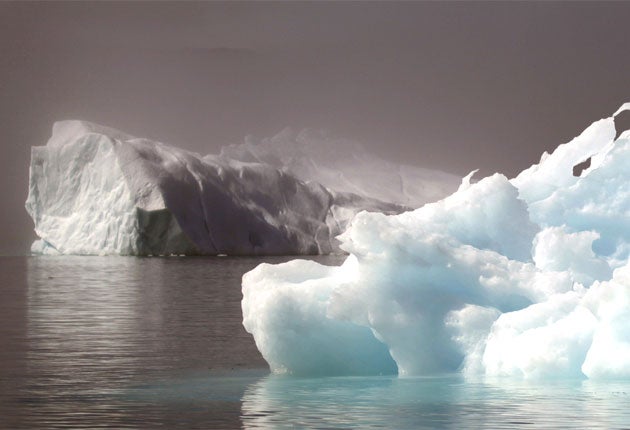Ancient glaciers are disappearing faster than ever
Satellite laser measurements show change in environment for the first time

Your support helps us to tell the story
From reproductive rights to climate change to Big Tech, The Independent is on the ground when the story is developing. Whether it's investigating the financials of Elon Musk's pro-Trump PAC or producing our latest documentary, 'The A Word', which shines a light on the American women fighting for reproductive rights, we know how important it is to parse out the facts from the messaging.
At such a critical moment in US history, we need reporters on the ground. Your donation allows us to keep sending journalists to speak to both sides of the story.
The Independent is trusted by Americans across the entire political spectrum. And unlike many other quality news outlets, we choose not to lock Americans out of our reporting and analysis with paywalls. We believe quality journalism should be available to everyone, paid for by those who can afford it.
Your support makes all the difference.Melting ice is pouring off Greenland and Antarctica into the sea far faster than was previously realised because of global warming, new scientific research reveals today.
The accelerating loss from the world's two great land-based ice sheets means a rise in sea levels is likely to happen even more quickly than UN scientists suggested only two years ago, the findings by British scientists suggest.
Although floating ice, such as that in the Arctic Ocean, does not add to sea-level rise when it melts as it is already displacing its own mass in the water, melting ice from the land raises the global sea level directly. At present it is thought that land-based ice melt accounts for about 1.8mm of the current annual sea level rise of 3.2mm – the rest is coming from the fact that water expands in volume as it warms. But the new findings, published online today in the journal Nature, imply that this rate is likely to increase.
High-resolution satellite laser measurements have shown that along both the Greenland and Antarctic coastlines, the glaciers and ice streams which for thousands of years have slowly carried ice into the sea are now rapidly thinning, meaning they are speeding up in their flow. In both cases, the increased flow rate is extending back far into the ice sheets' interior.
This is happening all the way around Greenland, even at the high northern latitudes, and around much of Antarctica, especially in West Antarctica and around the Antarctic Peninsula.
Areas around the Greenland coast are hotspots of glacier thinning – in some cases the glacier surface level is dropping at a rate of half a metre per year, while in others it is a remarkable rate of a metre and a half.
It is the first time that a comprehensive view of the rate of thinning – and thus ice loss – all the way around the coast has been made possible. It has been put together by Hamish Pritchard and his colleagues from the British Antarctic Survey and the University of Bristol, by analysing millions of measurements from Nasa's high-resolution ICESat (Ice, Cloud and Land Elevation Satellite).
Launched in January 2003, ICESat examines changes in the world's ice and land masses. The satellite's lasers have measured the surface elevation of the Earth's ice sheets with unprecedented accuracy – and thus picked up how they are changing.
"The fact that the changes are so large is alarming, and you wonder how far they will go," Dr Pritchard said. "The thinning effect must be relatively recent, as it is so strong that it could not have been sustained previously without the glaciers melting away."
The scientists compared the rates of change in elevation of both fast-flowing and slow-flowing ice. In Greenland, they studied 111 fast-moving glaciers and found 81 thinning at rates twice that of slow-flowing ice at the same altitude. They found that ice loss from many glaciers in both Antarctica and Greenland is greater than the rate of snowfall further inland.
In Antarctica, some of the fastest thinning glaciers are in the west, where the Pine Island, Smith and Thwaites Glaciers are thinning by up to nine metres per year.
"We were surprised to see such a strong pattern of thinning glaciers across such large areas of coastline – it's widespread and in some cases thinning extends hundreds of kilometres inland," Dr Pritchard said. "This kind of ice loss is so poorly understood that it remains the most unpredictable part of future sea level rise."
* Humanity must stay within the defined boundaries of several of the Earth's natural processes or face catastrophe, a group of leading environmental scientists warns today. The scientists, who include James Hansen of Nasa, the world's leading climatologist, suggest in the journal Nature that nine Earth-system processes are among the planetary boundaries: climate change, ocean acidification, interference with the global cycles of nitrogen and phosphorus, freshwater use, changes in land use, atmospheric aerosol loading, chemical pollution and rate of biodiversity loss.
For three of these – the nitrogen cycle, the rate at which species are being lost and anthropogenic climate change – they argue that the acceptable boundary level has already been passed. In addition, they say that humanity is fast approaching the boundaries for freshwater use, for converting forests and other natural ecosystems to cropland, for acidification of the oceans and for the phosphorous cycle.
Join our commenting forum
Join thought-provoking conversations, follow other Independent readers and see their replies
Comments